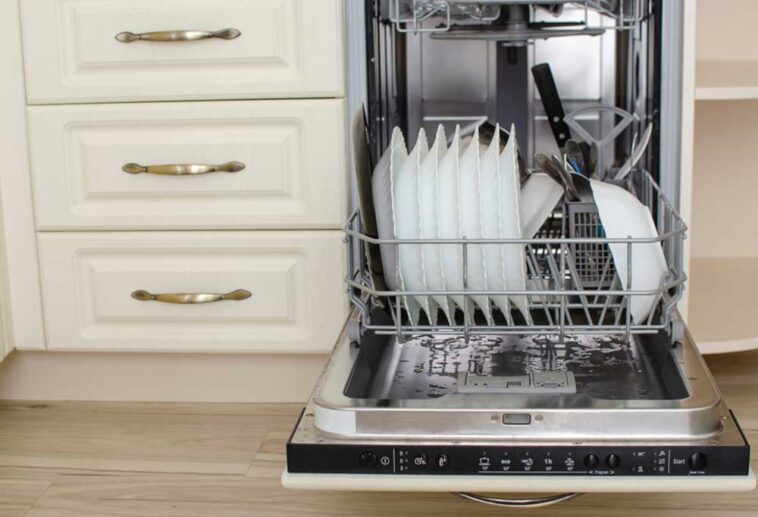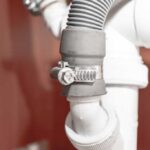When you buy appliances, you expect to save time and energy. Appliances are designed to help out around the home and make life a little easier. However, machines are not perfect and every once in a while, they will break down or get clogged.
When that happens to your dishwasher, you got to do a little hard work to get it running like normal. To learn how to get your dishwasher running like new again when it has standing water just keep reading our article. It has the information you will want to know about.
Prepare Your Dishwasher

This is a key step in getting your dishwasher to drain like it used to do. It takes a little work to get through this step, but it needs to be done if you want to unclog your dishwasher safely.
- Unplug The Appliance – You do not want any power running to the appliance while you are working.
- Disconnect The Water Line – While not dangerous this is a good step to take to avoid accidents.
- Remove All Dishes, Etc. – You will want to have a clear working area so remove the dishes, racks, and all removable obstructions.
- Clean Out Any Standing Water – In order to not make a mess in your kitchen and all over yourself, use a small pot or cup to remove any standing water inside the dishwasher.
- You may want to wear gloves to keep your hands clean while you work. It may get messy
The Different Methods to Use to Drain Your Dishwasher

1. Clean Your Filter
Believe it or not, the filter can be a major culprit in this situation. Once it gets clogged the water has no real place to go. This vital part is located below the spray arms and needs to be twisted counterclockwise to be removed.
Be aware that not all filters look the same as some can be cylindrical while others look like a flat plate. If you are not sure where your filter is, look in your owner’s manual to find the exact location.
Once the filter is removed, check its area for debris and clean out any you find. Then wash the filter to get all the debris from that part. Use a little hot water and soap to kill any bacteria. After you are done, just re-install the filter and put everything back.
2. Check the Air Gap
The duty this invention has is to stop your sink from draining into your dishwasher. If it gets clogged, you will need to remove the cap and clean out any debris blocking the drainpipe or hose.
Test the air gap to make sure you got all the debris out and that it is allowing proper drainage.
3. The Drain Hose May Be Clogged

This happens as some people do not do a pre-rinse and large chunks of debris get caught in the hose. Once that happens those larger chunks can block smaller ones and creates a dam inside the hose.
In order to properly clean the hose, you will need to pull the dishwasher out of its place and disconnect it. Sometimes you will have to remove the kick plate to access the hose connection.
Once the hose is off, run a brush or a wire with a rag tied to one end through the hose. This will clear out any blockage you may have. Make sure to check the openings the hose is attached to see if the blockage is located at those two points.
When you are satisfied that the hose is clear, re-attach it and put the dishwasher back into place.
4. Clean the Drain Valve
This part is inside the dishwasher, and you will have to let the appliance cool down first before tackling this cleaning job. The drain valve is usually near the motor and should be at the lowest point inside the appliance.
One part you will need to check first will be the gate arm. This has springs attached to it and if the arm or the springs are damaged, that may be the source of your problem. You will have to replace the damaged parts and then run a test to see if you cleared the problem.
If not, check the solenoid to see if it is working properly. If that part is not working right, it too will have to be replaced. Finally, check the motor to see if it is still in perfect shape.
You may be able to solve the problem by turning the motor by hand and free it up. if not you should run some tests to see if it is wearing out or broken. Replacement is the usual fix here.
5. The Garbage Disposal

It is possible that this handy appliance never crossed your mind as being the source of the problem. But since the dishwasher drains through the garbage disposal, the disposal may be clogged and stopping the draining process.
If the garbage disposal is full of debris, then you will need to clean it out before your dishwasher drains properly again. To do this you need to unplug the device and disconnect it from the sink drain and the dishwasher.
Then you can use a screwdriver to clean out any leftover food items, etc., Also, wash the garbage disposal to get any hidden debris your screwdriver missed. When you are done, re-attach the garbage disposal and plug it back in. Re-attach the dishwasher drain hose as well.
Some Final Words
Making sure your dishwasher drains properly can get a bit messy. Make sure to lay some cloths down in order to protect your kitchen floor and cabinets. Count on spending at least an hour handling the different parts and getting them unplugged.
If by chance the problem is not solved, then it is time to call in the professionals and let them handle the repair.
Please keep in mind that we may receive a small commissions when you click our links and make purchases. However, this does not impact our reviews and comparisons. We try our best to keep things fair and balanced, in order to help you make the best choice for you.




